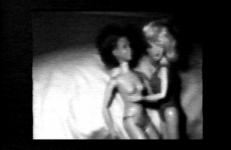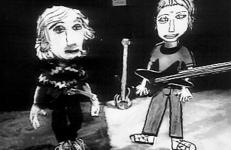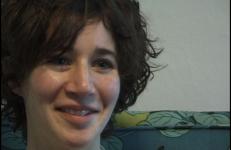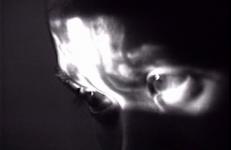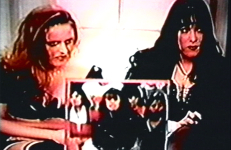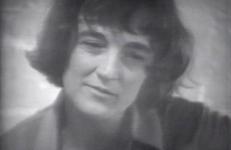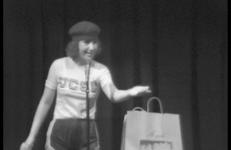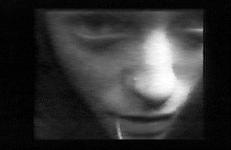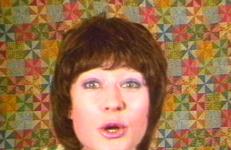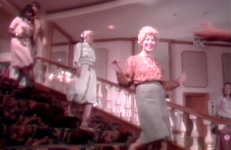A video in two parts (Starstruck and MGM: Movie Goddess Machine), focusing on celebrity culture, identity, and the body. “What is Liz Taylor doing in my bed, in the bed of my friend Leland, as he dies of AIDS?” These and related questions are enacted in a series of encounters between the artist/ performer/ spectator and a host of famous people from la Liz to Anita Hill. In Joan Sees Stars, Braderman addresses the subversive potential of masquerade in a parade of video-assisted star sightings.
Feminism
Taking queer artistic license, Dougherty and Leslie Singer together portray a gay male playwright who took 1960s London by storm. The result is a witty play on narcissism and split personality that captures the banality of stardom while paying tribute to promiscuity and transgression. Filmed in black and white pixelvision and color video, this tape continues Dougherty’s exploration of counter-culture identity through lesbian portrayal, the same ingenious bait-and-switch device seen at work in the lesbian portrayal of the Beatles in her earlier tape, Grapefruit.
Benning gives a chronology of her crushes and kisses, tracing the development of her nascent sexuality. Addressing the camera with an air of seduction and romance, giving the viewer a sense of her anxiety and special delight as she came to realize her lesbian identity.
This title is also available on Sadie Benning Videoworks: Volume 1.
These five short videos introduce Judy, a paper maché puppet who ruminates on her position in society. Like Judy, of the famous Punch and Judy puppet duo, Benning’s Judy seems to experience the world from the outside, letting things happen to her rather than making things happen around her.
This title is also available on Sadie Benning Videoworks: Volume 3.
Miranda July (b.1974) makes performances, movies, and recordings—often in combination. Her videos (The Amateurist, Nest of Tens, Getting Stronger Every Day) present complicated parallel narratives with characters who experience loneliness, exploitation, unexpected phobias, and often inexplicable relationships. July has also recorded several performance albums released by Kill Rock Stars and K Records. In 1995 she founded Joanie 4 Jackie, an on-going movie distribution network for independent women movie makers.
Since the 1970s Mary Kelly (b.1941) has worked at the fore of feminist art and theory. She has continued to address issues and methods of activist politics, psychoanalysis, political science, literature, and the history of women and gender. Kelly received recognition in the early ’80s for her epic six-year project, The Post Partum Document, a mixed-media work chronicling her and her son’s development. Kelly says her work revolves “around the recurring themes of body, money, history, and power” in this interview with Judith Russi Kirschner.
Using selected details of TV’s Hollywood Squares, Birnbaum constructs an analysis of the coded gestures and “looks” of the actors, including Eileen Brennen and Melissa Gilbert. Birnbaum exposes television as an agent of cultural mimicry and instruction. The actors’ expressions are far from valueless; they are the ideological content of such programming.
By focusing on the blindfold, kore explores the eye as purveyor of desire, sexual fear, and the fantasy of blindness. An alternative sexuality is founded in touch-based (feminine?) pleasure as opposed to a vision-based (masculine?) pleasure. An examination of institutional blindspots towards women, and people of color, concerning AIDS expands on the issue of vision, visibility and the disease.
This title is also available on Tran, T. Kim-Trang: The Blindness Series.
Joyce Kozloff was at the forefront of the 1970s pattern and decoration movement—a feminist effort to incorporate typically “feminine” and popular decorative arts into the fine arts. She has been involved with public art and murals for more than two decades. In this video, Kozloff prepares and installs her mural Around the World on the 44th Parallel, which features sections of maps from 12 cities around the world on the same latitude. The work was constructed at the Tile Guild in Los Angeles and installed at the library at Minnesota State University-Mankato.
Screened in the 1997 Whitney Biennial, the video Ladies, There's a Space You Can't Go is both a deconstruction and a distortion of an episode of Sally Jesse Raphael titled My Daughter Dresses Like A Hooker. Sampled audience statements and a driving dance beat merge with distorted talk show participants to form a self-mutilating music video. The daughters "exhibited" walk through the audience as if it were a runway.
The Baroness Elsa von Freytag-Loringhoven né Plotz, was an unsung member of the Dada Movement. A poet, artist, runaway, and all around public provocateur; she actively did not fit into her historical moment, and like most misfits, suffered for it. As with many women artists throughout history, her cultural legacy has been obscured and in some instances appropriated into the oeuvres of better known male peers.
Laurie was inspired by Laurie Weeks’ uncanny ability to simultaneously embody her characters and write them from a clear distance. The text in question is just a few paragraphs from a draft of the novel Zipper Mouth, more than ten years in the making, and published by the Feminist Press.
A classic feminist video, Learn Where the Meat Comes From depicts how “gourmet carnivore tastes take on a cannibalistic edge. This parody of a Julia Child cooking lesson collapses the roles of consumer and consumed: Lacy instructs us in the proper butcher’s terms for cuts of meat by pointing them out on her body. As the lesson progresses she becomes more and more animal-like, growling and baring over-sized incisors. Perhaps, in her role as a gourmet cook, she is herself as much consumed as consumer.”
This video is related to Seven Years of Living Art (a seven-year performance of personal endurance Montano began in December of 1984) and adopts the Zen Chakra system of seven centers as a structuring device. The adoption of the Chakra system arises from Montano’s commitment to the study of Eastern culture and religion.
Lucy Lippard (b. 1937) earned degrees from Smith College and New York University before beginning her career as an art critic in 1962, when she began contributing to publications such as Art International and later, Artforum. In 1966, she organized an exhibition entitled Eccentric Abstraction at the Fischbach Gallery in New York City.
Lucy Lippard (b. 1937) earned degrees from Smith College and New York University before beginning her career as an art critic in 1962, when she began contributing to publications such as Art International and, later, Artforum. In 1966, she organized an exhibition entitled “Eccentric Abstraction” at the Fischbach Gallery in New York City. “Eccentric Abstraction” set the standard for what would later be regarded as postminimalism, process, or antiform art.
Two women occupy one space. Without showing their faces, the camera lingers on their bodies in images that capture both from an extreme high angle. The camera distorts the female body, even creating a grotesque effect. A voice repeatedly calls for a woman: “Lisa, come here, don’t be afraid… that’s it, I won’t hurt you.” A video which explores the gaze on the female body, and the desires and violence overwhelming it.
This title is also available on Hester Scheurwater Videoworks: Volume 1.
Live in San Diego is my first live performance. David Antin, my mentor when I was a graduate student at the University of California at San Diego, encouraged me to perform in front of an audience. Why? Since my videos directly addressed the camera- why not take the next step and address a live audience?
When she was 16, Benning stopped going to high school for three weeks and stayed inside with her camera, her TV set, and a pile of dirty laundry. This tape mirrors her psyche during this time. With the image breaking up between edits, the rough quality of this early tape captures Benning’s sense of isolation and sadness, her retreat from the world. As such, Living Inside is the confession of a chronic outsider.
This title is also available on Sadie Benning Videoworks: Volume 1.
An exploration of cruising glory holes, feminism, and general queer frustration.
Treating the problem of anorexia nervosa from the parents' perspective, Rosler presents a mother and father speaking about the tragedy of their daughter's death as a result of dieting. The conversation turns toward the irony of self-starvation in a land of plenty and toward the international politics of food, where food aid is used as a negotiating tool. Confronting a serious issue, Rosler simultaneously sets into play the confessional form and the ghoulish staginess of talk show dramatics.
Combining Rubnitz’s skillful manipulation of the familiar “look” of TV shows with an extraordinary range of characters, performer Ann Magnuson convincingly impersonates the array of female types seen on TV in a typical broadcast day. From glitzy to drab, from friendly housewife to desperate evangelist, Magnuson is a one-woman universe appearing on every channel, the star of every program—giving her all as the chameleon woman who is always on display.
Combining Rubnitz’s skillful manipulation of the familiar “look” of TV shows with an extraordinary range of characters, performer Ann Magnuson convincingly impersonates the array of female types seen on TV in a typical broadcast day. From glitzy to drab, from friendly housewife to desperate evangelist, Magnuson is a one-woman universe appearing on every channel, the star of every program—giving her all as the chameleon woman who is always on display.
"Mama mama mama...," a woman calls out again and again, over and over. Is it her child that she mimics, or is she calling for her own mother? A desperate video performance in the first person.
This fictional docudrama—based in part on the careers of Anita Bryant, Phyllis Schlafly, and Marabel Morgan—covers the fictitious assassination of Clovis Kingsley, a powerful, pro-family, anti-feminist ideologue, and fictional author of The Power of Total Submission. The narrative is reconstructed in fractured and contradictory flashbacks by those who knew her best and liked her least. The tape travels beyond the faux biography to suggest that the logic of anti-feminism is a strategy of the disempowered.






